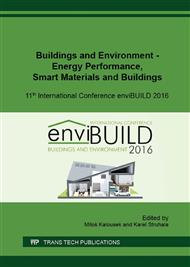[1]
H. V. Fuchs, Schallabsorber und Schalldämpfer. Springer-Verlag, Berlin-Heidelberg, (2000).
Google Scholar
[2]
Z. Nunes, B. Wilson, M. Rickard, An assessment of the acoustic performance of open windows, in line with ventilation requirements for natural ventilation, In: 39th International Congress on Noise Control Engineering, Sociedade Portuguesa de Acustica, Lisbon, (2010).
Google Scholar
[3]
C. Buratti, Indoor noise reduction index with open window. Appl. Acoust. 63 (2002) pp.431-451. (2002).
DOI: 10.1016/s0003-682x(01)00040-8
Google Scholar
[4]
T.D. Rossing (ed. ), Springer Handbook of Acoustics, Springer Science + Business Media, New York, (2007).
Google Scholar
[5]
M. H. De Salis, D. J. Oldham, and S. Sharples, Noise control strategies for naturally ventilated buildings. Build. Environ. 37 (2002) pp.471-484.
DOI: 10.1016/s0360-1323(01)00047-6
Google Scholar
[6]
D. J. Oldham, M. H. De Salis, and S. Sharples, Reducing the ingress of urban noise through natural ventilation openings, Indoor Air 14 (2004) pp.118-126.
DOI: 10.1111/j.1600-0668.2004.00294.x
Google Scholar
[7]
A. Khalegi, K. Bartlett, and M. Hodgson, Relationship between ventilation, air quality and acoustics in green' and 'brown, buildings, 19th International Congress of Acoustics, Madrid, (2007).
Google Scholar
[8]
A. Mahdavi. Thermal and Acoustical Performance of Buffer Rooms,. ASHRAE Transactions, Volume 99 (1993) pp.1092-1105.
Google Scholar
[9]
J. Kang, and M.W. Brocklesby, Feasibility of Applying Micro-Perforated Absorbers in Acoustic Window Systems, Appl. Acoust. 66 (2005) pp.669-689.
DOI: 10.1016/j.apacoust.2004.06.011
Google Scholar
[10]
C.D. Field, Acoustic design criteria for naturally ventilated buildings, J. Acoust. Soc. Am. Vol. 123 (2008) pp.3814-3814.
DOI: 10.1121/1.2935546
Google Scholar
[11]
C. Bibby, M. Hodgson, Field measurement of the acoustical and airflow performance of interior natural-ventilation openings and silencers. Build. Environ. 67 (2013) pp.265-273.
DOI: 10.1016/j.buildenv.2013.05.025
Google Scholar
[12]
A. Mahdavi, O. Çakir, C. Pröglhöf, J. Lechleitner, Sound insulation of a double-leaf wall system with openings for natural ventilation. Proceedings of the 5th International Building Physics Conference (IBPC), Kyoto, 2013, pp: 1115-1118.
Google Scholar
[13]
A. Mahdavi, E. Bajraktari, M. Hintermayer, and J. Lechleitner. Sound Insulation of Double Facades with Operable Windows: an Empirical Inquiry, In: CLIMA 2013 - 11th REHVA World Congress and the 8th International Conference on Indoor Air Quality, Ventilation and Energy Conservation in Buildings", K. Kabele, M. Urban, K. Suchý, M. Lain (Ed. ); Society of Environmental Engineering (STP), 2013, 8 p.
DOI: 10.1016/j.egypro.2015.11.129
Google Scholar
[14]
Information on: http: /www. sonatech. at.
Google Scholar
[15]
Information on: www. microsorber. com.
Google Scholar
[16]
EN ISO 10140-2: Acoustics – Laboratory measurement of sound insulation of building elements – Part 2: Measurement of airborne sound insulation, International Organization for Standardization, Geneva, (2010).
DOI: 10.3403/30087649u
Google Scholar
[17]
R. Makarewicz, Y. Sato, Representative spectrum of road traffic noise, J. Acoust. Soc. Jpn. (E) 17 (1996) pp.249-254.
DOI: 10.1250/ast.17.249
Google Scholar
[18]
L. Nagel, O. Pederson, SPICE (Simulation Program with Integrated Circuit Emphasis). University of California, Berkeley, (1973).
Google Scholar
[19]
Information on: http: /www. linear. com/designtools/software.
Google Scholar
[20]
M. E. Van Valkenburg, In memoriam: Hendrik W. Bode (1905-1982), IEEE T. Automat. Contr. 29 (1984) p.193–194.
DOI: 10.1109/tac.1984.1103509
Google Scholar
[21]
J. Gu, and S.F. Yau. A model-based approach to active noise cancellation using loudspeaker array, In: 1997 IEEE International Conference on Acoustics, Speech, and Signal Processing. ICASSP-97, Munich, 1997, pp.379-382.
DOI: 10.1109/icassp.1997.599652
Google Scholar
[22]
E. Bajraktari, J. Lechleitner, and A. Mahdavi. Estimating the sound insulation of double facades with openings for natural ventilation. Energy Procedia 78 (2015) pp.140-145.
DOI: 10.1016/j.egypro.2015.11.129
Google Scholar


